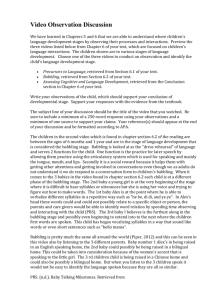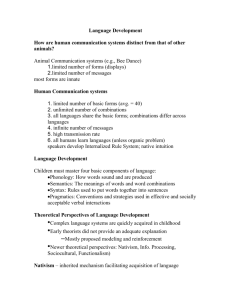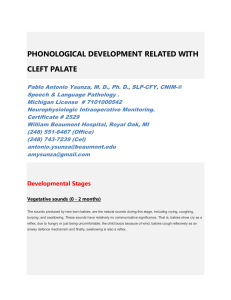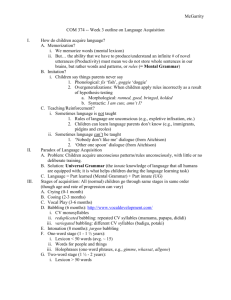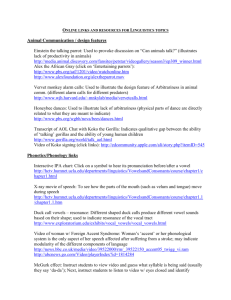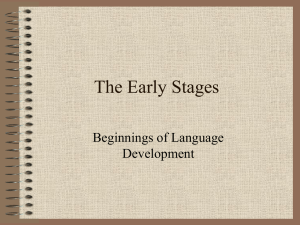Gillis S, Schauwers K, Govaerts, P. Babbling milestones and beyond
advertisement
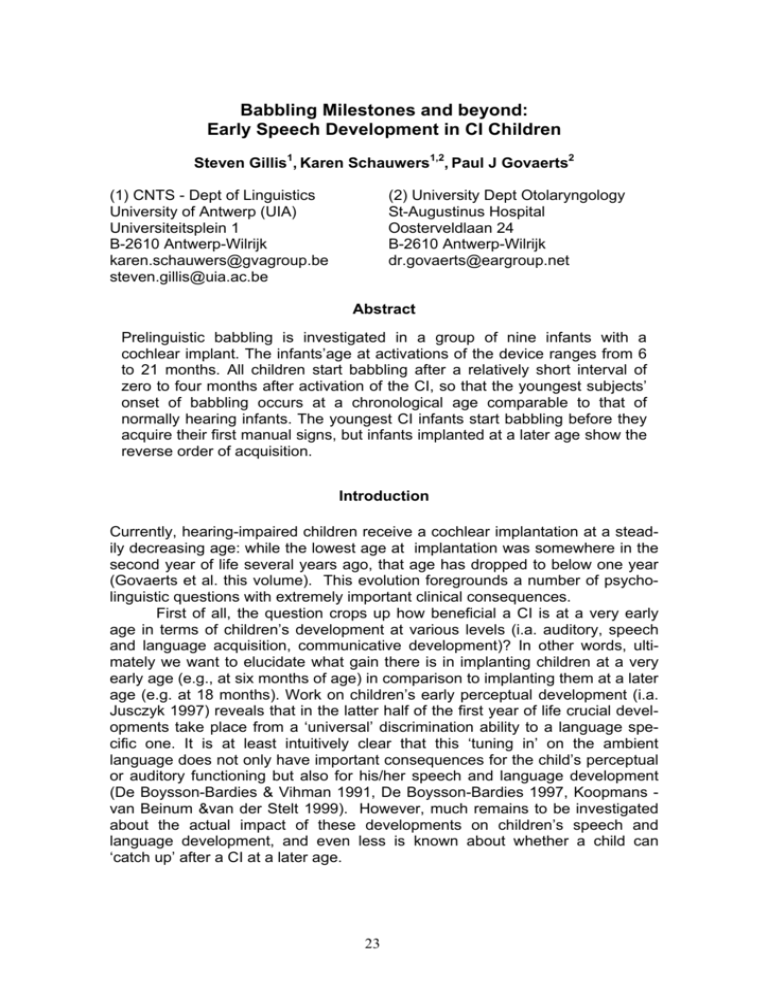
Babbling Milestones and beyond: Early Speech Development in CI Children Steven Gillis1, Karen Schauwers1,2, Paul J Govaerts2 (1) CNTS - Dept of Linguistics University of Antwerp (UIA) Universiteitsplein 1 B-2610 Antwerp-Wilrijk karen.schauwers@gvagroup.be steven.gillis@uia.ac.be (2) University Dept Otolaryngology St-Augustinus Hospital Oosterveldlaan 24 B-2610 Antwerp-Wilrijk dr.govaerts@eargroup.net Abstract Prelinguistic babbling is investigated in a group of nine infants with a cochlear implant. The infants’age at activations of the device ranges from 6 to 21 months. All children start babbling after a relatively short interval of zero to four months after activation of the CI, so that the youngest subjects’ onset of babbling occurs at a chronological age comparable to that of normally hearing infants. The youngest CI infants start babbling before they acquire their first manual signs, but infants implanted at a later age show the reverse order of acquisition. Introduction Currently, hearing-impaired children receive a cochlear implantation at a steadily decreasing age: while the lowest age at implantation was somewhere in the second year of life several years ago, that age has dropped to below one year (Govaerts et al. this volume). This evolution foregrounds a number of psycholinguistic questions with extremely important clinical consequences. First of all, the question crops up how beneficial a CI is at a very early age in terms of children’s development at various levels (i.a. auditory, speech and language acquisition, communicative development)? In other words, ultimately we want to elucidate what gain there is in implanting children at a very early age (e.g., at six months of age) in comparison to implanting them at a later age (e.g. at 18 months). Work on children’s early perceptual development (i.a. Jusczyk 1997) reveals that in the latter half of the first year of life crucial developments take place from a ‘universal’ discrimination ability to a language specific one. It is at least intuitively clear that this ‘tuning in’ on the ambient language does not only have important consequences for the child’s perceptual or auditory functioning but also for his/her speech and language development (De Boysson-Bardies & Vihman 1991, De Boysson-Bardies 1997, Koopmans van Beinum &van der Stelt 1999). However, much remains to be investigated about the actual impact of these developments on children’s speech and language development, and even less is known about whether a child can ‘catch up’ after a CI at a later age. 23 Studying very young children also brings in fundamental methodological problems, in addition to fundamental psycholinguistic questions. There is a need for appropriate tools for assessing very young children’s speech perception abilities and for assessing their actual speech and language production. Testing one-year-olds or younger children requires different methods than testing a three- or four-year-old. Moreover, assessing the sound and speech production of a child in the first year of life, requires different descriptive categories than those used for older children: the traditional grammatical categories (such as phonemes, words, grammatical constructs) used in psycholinguistic investigations are obviously not adequate and/or appropriate. The aim of this paper is to provide the preliminary results of a longitudinal investigation of CI children’s sound and language production. Our subjects are CI children implanted in the course of the first (4 subjects) and the second year of life (5 subjects). We specifically study their ‘prelinguistic’ vocalizations and the appearance of ‘babbling’ as a milestone in their vocal production. The setup of the study permits us to formulate provisional answers to the question about the impact of age of implantation on the quality and the quantity of early vocal development and to the question how these CI children’s early vocal development relates to normally hearing (henceforth: NH) and hearing impaired (henceforth: HI) children’s development. In what follows we will first dwell upon the nature of children’s prelexical vocalizations, and upon what is known of NH and HI children’s vocal development. This will constitute the background against which we will cast CI children’s development. Prelinguistic vocal development The literature shows a coherent picture of hearing children’s vocal development during their first year of life (or more precisely: during the prelexical period) notwithstanding analyses according to rather divergent analytical frameworks. Researchers analyzed prelexical vocalizations from various perspectives. They provided phonetic and acoustic characterizations (Roug, Landberg & Lundberg 1989, Nakazima 1975, Stark 1980, 1986), phonological analyses (StoelGammon 1989, 1994), metaphonological analyses (Oller 1980, 1986), as well as articulatory and phonatory studies (Koopmans – van Beinum & van der Stelt 1986). There is fair agreement as to the order of appearance of particular developmental stages which reflects the highly organized way in which various vocalization types occur. In Table 1 an overview is presented of the stages of vocal development (with approximate age indications) that have been identified in the literature. Although not all ages and not all stages completely coincide, inspection of the table reveals that a highly similar development is identified. The stage that is identified most readily and is defined most clearly in all analyses presented in Table 1 is the ‘babbling’ stage. Babbling is defined as 24 Table 1. Comparative overview of stages of speech development in the first year of life Koopmans- van Beinum & van der Stelt (1986) Stage 1 Stage 2 Stage 3 Stage 4 Stage 5 Stage 6 Uninterrupted phonation (0 - 6 weeks) Interrupted phonation (6 - 10 weeks) One articulatory movement with continuous or interrupted phonation (10 - 20 weeks) Variations in the phonatory domain (20 - 26 weeks) Reduplicated articulatory movements (26 - 40 weeks) Nakazima (1975) Oller (1980, 1986) Crying; beginning of noncry sounds (0 - 1 month) Begin phonation of noncry sounds (1 month) Development of articulation (2 - 5 months) Repetitive babbling (6 - 8 months) Phonation (0 - 2 months) Glottal stage (2 - 3 months) Goo stage (2 - 4 months) Velar / Uvular stage (3 - 4 months) Expansion stage Vocalic stage (4 - 6 months) (4 - 6 months) Canonical babbling (7 - 10 months) Development of prelin- Variegated babguistic communication bling (10 - 12 months) in voice (9 - 12 months) 25 Roug et al. (1989) Reduplicated consonant babbling (6 - 10 months) Variegated consonant babbling (10 - 12 months) Stark (1980, 1986) Reflexive crying and vegetative sounds (0 - 8 weeks) Cooing and laughter (8 - 20 weeks) Vocal play (16 - 30 weeks) Reduplicated babbling (25 - 50 weeks) Nonreduplicated babbling (after 50 weeks) reduplicated sequences of consonants (C) and vowels (V).2 The repetition of CV sequences gives rise to the labels ‘repetitive babbling’, ‘reduplicated babbling’ or ‘canonical babbling’. Babbling represents an important achievement in the child’s vocal development, since a CV sequence is considered to be the ‘simplest’ syllable and the syllable is the phonetic building block of adult words. This means that when the child starts babbling, he/she is at least phonetically speaking at the threshold of word use, at the border between the prelexical and the lexical stage. The studies reviewed in Table 1 agree that children start babbling in the age range from 6 to 10 months. In the babbling stage a distinction is made between ‘reduplicated’ and ‘variegated’ babbling. In ‘reduplicated’ babbling the same syllable is repeated throughout the babbling episode. In ‘variegated’ babbling consonants, or vowels or both can be different. According to some studies reduplicated and variegated babbling occur in two successive stages (Oller 1980, Stark 1980, Elbers 1982). Other studies have shown that not all children exhibit such a clear progression: variegated babbling has been shown among the very early babbling sequences (Davis & MacNeilage 1995, Mitchell & Kent 1990, Smith, Brown-Sweeney & Stoel-Gammon 1989). In Table 1 also other important distinctions are made: for vocal development the distinction between cry and non-cry sounds is crucial. The latter sounds are egressive such as normal speech sounds, while the former are ingressive as well as egressive. For vocal development the distinction between vegetative and non-vegetative sounds implies the use of the vocal tract for phonation (as in normal speech sounds) versus the use of other sources of phonation. These distinctions point at ‘non-vegetative, non-cry comfort sounds’ as the main locus to look for precursors of babbling (and later language). The origin of babbling. The fact that babbling consists of CV syllables and that CV is the universally preferred syllable type leads to the hypothesis that something innate is at stake in children’s use of CV syllables in their early vocal production. Indeed, if all languages of the world share CV syllables while other types of syllables (such as CVC, CCV, VCC, etc.) do not occur across languages, and if all children start with CV syllables while other types of syllables are later to appear (Levelt & Van de Vijver in press), may be somehow ‘given’ to the child. Evidence for this hypothesis comes from studies of children’s motor development. In an investigation of 51 children’s gross motor development, Van der Stelt & Koopmans – van Beinum (1986) found a particular sequence in motor development, and established the specific place that babbling appears to occupy in it. Just as rolling from prone to supine and rolling from supine to prone occur in a particular developmental order, babbling also seems to occupy a fixed position in that developmental order. Similar views are expressed by other investigators: Wallace, Menn & Yoshinago-Itano (2000, see also Koopmans – van Beinum & van der Stelt 1998) argue that the onset of babbling requires rhythmic jaw movements and simultaneous phonation, a coordination 2 Note that some authors accept a child’s vocalization as a ‘babble’ if it consists of a consonant and a vowel (i.a. Oller et al. 1976). In this paper, as in most of the relevant literature the reduplication of CV sequences is considered to be a defining characteristic of babbling. 26 that seems to be linked to the onset of rhythmic limb waving (Thelen 1991) and, hence, probably driven in large part by the child’s timetable for motor maturation. Mandibular oscillation is also advanced as the core explanatory concept of babbling by MacNeilage and colleagues (Davis & MacNeilage 1990, 1994, 1995, MacNeilage & Davis 1990a, b, 1991, MacNeilage, Davis, Kinney & Matyear 1999, Matyear, MacNeilage & Davis 1997, Redford, MacNeilage & Davis 1997). The safest conclusion that can be drawn from these studies is that babbling is determined to some extent by maturation, and in this sense it can be considered as a motorical milestone (Koopmans – van Beinum & van der Stelt 1986). The question remains if the onset of babbling is more than just a motorical milestone. If that were the case, we would expect (severely) hearing impaired children to start babbling at the same age as normal hearing children. Babbling and audition. Do young HI children start babbling at the same age as NH children? As to the timing of the onset of babbling, the current view expressed in the literature is that HI children start babbling much later than NH children. Oller & Eilers (1988) found that the 21 NH children in their study started babbling between 6 and 10 months of age, while none of the 9 HI children started babbling before 14 months of age. Koopmans – van Beinum and colleagues report similar findings: the mean age at which the 54 infants in their sample started babbling was 30.8 weeks (Koopmans – van Beinum & van der Stelt 1986). But of the 6 profoundly HI children only one child started babbling in the expected age range, while none of the other HI children started babbling before 18 months of age (Koopmans – van Beinum, Clement & van den Dikkenberg – Pot 2001). The difference in the ages reported may be due to slight differences in the definitions of babbling used, but the bottom line is quite clear: HI children start babbling but they do so much later than NH children. Timing of the onset of babbling is only one aspect of the deviant sound production of HI children. Once they start babbling, their babbling ratio is lower than that of NH children, and on the whole their vocal production is characterized by a restricted formant frequency range, limited phonetic and syllabic inventories, longer duration, and lack of expressive jargon (Ertmer & Mellon 2001, Kent, Osberger, Netsell & Hustedde 1987, Lynch, Oller & Steffens 1989, Oller & Eilers 1988, Stark 1983, Stoel-Gammon & Otomo 1986, Stoel-Gammon 1988). The conclusion that can be drawn from this short overview of the relevant literature is that HI children’s babbling is deviant from NH children’s babbling both quantitatively and qualitatively. Thus hearing has an impact on the onset of babbling. Two notes of caution are in order here: first of all, this conclusion only holds for babbling (reduplicated CV sequences with or without variation) and not for all kinds of other vocalizations that children produce during their first year of life (see Table 1). In a series of studies comparing HI and NH children’s vocalizations in the first and second year of life, Koopmans – van Beinum and colleagues found that HI children vocalize more than NH children in their first year of life and the amount of vocalizations is statistically significant in the first year of life – though not in the second year of life (Clement, den Os & Koopmans – van Beinum 1994, Clement & Koopmans – van Beinum 1995, van den Dikkenberg – Pot & Koopmans – van Beinum 1997, van den Dikkenberg – Pot, 27 Koopmans – van Beinum & Clement 1998, Koopmans – van Beinum, Clement & van den Dikkenberg – Pot 2001). What also significantly differs between the two populations are the timing of the onset of babbling and the quality of the vocalizations (see below). A second note of caution relates to the definition of HI children, more specifically the amount of hearing loss. We already mentioned that some HI children do start babbling at approximately the same age as NH children. A case in point is mentioned by Koopmans – van Beinum et al. (2001): one of their subjects started babbling at 7.5 months of age, while all the other HI children did not start babbling before 18 months of age. The explanation the authors suggest is that the child had a usable hearing residue, particularly in the lower frequency range. This residue may have provided enough auditory input for babbling to take off. However, as Koopmans – van Beinum (p.c.) remarks, residual hearing is necessary for babbling, but it does not appear to be sufficient since children with a hearing loss comparable to the child mentioned above do not start babbling until much later. Thus even if children have a severe hearing loss, they may start babbling at the appropriate age. Consequently, it may concluded that indeed audition is necessary for the onset of babbling, and residual hearing may lead even HI children with a severe hearing loss to start babbling, though residual hearing does not seem to be sufficient in each case for babbling (though the exact conditions under which HI children start babbling at the appropriate age and other HI children do not start babbling at that age, are largely unknown). Describing prelexical vocalizations In this study we investigate young children’s prelexical vocalizations in relation to their chronological age and their age at implantation. In Table 1 an overview was presented of the major stages and milestones in NH children’s vocal development, but the question was not answered if the notions mentioned in the overview were all operationally defined. For babbling there is a clear definition, i.e. a sequence of CV-syllables. But young children produce many more different types of vocalizations (even before they start babbling). Thus the problem is how to characterize and describe them. Except for babbling, the question rises for clear links between the actual sound production and the descriptive categories used in the analysis. Close scrutiny of the relevant literature brought Koopmans – van Beinum & van der Stelt (1986, 1998) to the conclusion that clear and unambiguous operational definitions were needed for describing young children’s prelexical sound production. They proposed a sensori-motor approach that will be adopted in this study. The approach relies on the following distinctions and premises: - the basic unit of analysis is the respiratory cycle or the breath unit; two main aspects of the sounds produced in a breath unit are described: phonation (the larynx makes phonatory movements) and articulation (the vocal tract makes articulatory movements); 28 - with respect to phonation, the basic distinction is between no phonation, continuous and interrupted phonation; with respect to articulation the basic distinction is between no articulation, one articulatory movement, and two or more articulatory movements. Given these descriptive categories, each prelexical utterance can be described in terms of its phonatory and articulatory properties. For instance, the typical ‘gooing’ [∂R∂] (see Table 1) that children produce around the age of two months is described as a phonation that is interrupted by one articulatory movement, while a babble like [tatata] is described as phonation interrupted by two (or more) articulations. Koopmans - van Beinum & van der Stelt (1986) analyzed children’s sound production according to these categores and the established the development order displayed in Table 1. It shows the growing complexity of children’s vocal production. The underlying regularity appears to be the coordination of the phonatory and the articulatory movements, which culminates in ‘babbling’ in the prelexical stage. Method Participants The participants in this study were 9 HI and 5 NH children and their parents. All children had normal hearing parents. No clear health problems such as cognitive or motor delays were found in the children. Table 2 gives an overview of the auditory characteristics of the HI children who received a CI. In what follows they will be referred to as CI children. The CI children were diagnosed at the University Otolaryngology department of the St-Augustinus Hospital. In all cases in which diagnosis was possible, the cause of deafness was genetically based. All children were raised orally with sign support. Table 2 shows that all children had a hearing loss of more than 120 dB, except for Kl and Te. Their hearing loss with a hearing aid was, in most cases, not significantly different, except for Kl and Te. During the study Ro received a second CI, but this was at an age well beyond the critical babbling milestones that are studied in this paper. Table 3 provides details of the children’s ages at the onset of data collection. It can be readily seen that for three CI children the pre-CI recordings are missing (for one child, Mi, recordings made by the child’s parents are available). The other children were observed before surgery and approximately one month after surgery for the first post-CI. For the NH children, the first observation was scheduled at age 0;6. 29 Table 2. Overview of the characteristics of the CI children Participant ID Ethiology Ro e.c.i. As Mi Em Rb Am Kl Jo Te connexine 26 connexine 26 e.c.i. e.c.i. connexine 26 connexine 26 connexine 26 e.c.i. Hearing loss (dBHL) Fl unaided Fl aided Fl with CI R: 120 / R: 43 L: 120 / L: 43 130 130 30 130 100 45 130 130 30 130 130 45 130 130 45 80 45 35 130 130 45 110 60 ? 30 Device Type Nucleus 24 RCS Nucleus 24 RCS Nucleus 24 RCS Nucleus 24 M Nucleus 24 RCS Nucleus 24 RCS Nucleus 24 RCS Nucleus 24 RST Nucleus 24 RST Nucleus 24 RCS Age at implantation 0; 5. 5 1;3.9 0;6.21 0;8.23 0;10.0 1;1.7 1;1.15 1;4.27 1;6.5 1;7.14 Age at activation 0;6.4 1;4.8 0;7.20 0;9.20 0;11.20 1;2.4 1;2.27 1;5.27 1;7.9 1;9.4 Table 3. Overview of the onset of the recording sessions Participant ID CI Ro As Mi Em Rb Am Kl Jo Te NH Wi Sa Br Lu Ma Recording Pre CI First Recording Post CI No 0;6.9 No 0;10.20 1;2.0 1;2.6 No 1;7.15 1;8.21 0;6.27 0;8.16 1;2.29 0;11.30 1;2.25 1;3.21 1;6.13 1;8.13 1;9.23 n.a. n.a. n.a. n.a. n.a. 0;5.30 0;6.5 0;5.30 0;6.5 0;6.2 Data collection and transcription The children were visited in their homes by one of the authors (KS) once a month. Video-recordings of up to 60 minutes were made of spontaneous unstructured interactions between the child, one of the parents, and in some cases a sibling. The digital recordings were stored on a hard disk for further processing. From each recording a sample of approximately 20’ was taken. The sampling procedure was done by one person (KS) for all recordings and aimed at selecting delineated sequences of interactions. The selected sequences were subsequently transcribed according to the CHAT conventions (MacWhinney 1995). Transcription consisted of an orthographic transcription of the child’s and the adult’s (or adults’) utterances, and in case of prelexical vocalizations the utterance was transcribed with a placeholder (see below). For each utterance a link was established between the written transcript, the sound and the video images, so that in subsequent phases of data coding and analysis the actual recording could easily be inspected. The linking of the transcript and the audiovisual material was done in CED, the CHILDES dedicated editor. Subsequently the recordings were coded. First of all, each prelexical child utterance was coded for phonation and articulation characteristics. Each prelexical vocalization (more specifically, each ‘comfort sound’) was coded according to the descriptive categories established by Koopmans – van Beinum & van der Stelt (1986). This coding consisted of determining for each sound where it fitted in the following matrix: 31 Phonation type No Phonation Uninterrupted Phonation Interrupted Phonation Articulation type No Articulation n.a. One Articulation Two or more Arrticulations n.a. Each utterance also received a CV-code, i.e., the utterance was broken-up in a sequence of consonant- and vowel-like elements. For each segment – C or V – the defining characteristics were established in terms of place and manner of articulation (for consonants) and in terms of vowel height and closure (for vowels). Once the children started using lexical items, these were transcribed phonemically, while their signed utterances were transcribed with a separate code as part of the orthographic transcription. Transcription and coding were organized in three phases. In a first pass a trained full-time research assistant or a student research assistant transcribed/coded the data. In a second pass the transcription/coding were checked by the second author of this paper, KS. In a third pass AWK scripts developed by G. Durieux were run over the transcripts / codings in order to eliminate all remaining formal errors in the transcript files. Results In Figure 1 the evolution of our youngest subject’s (Ro) vocalizations is plotted. The figure shows the percentage of vocalizations according to the number of articulatory movements (0 Art, 1 Art, 2+ Art). At first, vocalizations without articulatory movements predominate. Vocalizations with one movement soon reach the 20% level (at age 0;8.29). The main point of interest is the line representing two or more articulatory movements, i.e. babbling. When does Ro start babbling? It depends on the criteria used: either the first occurrence of babbling is selected, or the well pronounced and often remarked ‘babbling spurt’ is selected. Thus for Ro the onset of babbling is at age 0;8.1 and the babbling spurt occurs between 0;9.26 and 0;11.2. In what follows we will study babbling using both criteria seperately: the onset of babbling and the babbling spurt. For the onset of babbling the age of the first occurrence of vocalizations with two or more articulatory movements is selected, provided that a minimum of two such vocalizations occur and provided that babbling occurs in three consecutive observation sessions (unless the babbling spurt intervenes). The babbling spurt occurs when the percentage of vocalizations with two or more articulatory movements suddenly increases, i.e. jumps over 10% of the child’s vocalizations and reaches a level that is at least the threefold of that of the previous observation session. 32 100 90 80 70 60 50 40 30 20 10 0; 6. 27 0 Figure 1: Percentage vocalizations without articulatory movements (0 Art), with one (1 Art) and two or more articulatory movements (2+ Art) of subject Ro On the basis of these criteria we can assess the age at the onset of babbling and the age which the babbling spurt occurs. As a matter of course, the ages can be calculated in two ways: (1) we can consider the child’s chronological age and (2) the of time lapse between the activation of the CI and the occurrence of the babbling spurt, i.e. the child’s ‘hearing age’. Babbling and chronological age. Table 4 shows that all children start babbling at some point: the NH children in the age range 0;6 – 0;8, as expected, and the CI children start babbling after they received their implant. There are two exceptions: for Te the onset of babbling occurred pre-implant, and we suspect that also Kl started babbling before he received his implant (unfortunately there is no pre-implant recording). The expected age for the onset of babbling is 31 weeks (SD 6.3 weeks) according to Koopmans – van Beinum & van der Stelt (1986), and between 7 and 10 months according to Oller & Eilers (1988). According to the latter figures, the earliest implanted infants, Ro and As, fall in the normal age range, 33 i.e., they start babbling at a chronological age at which NH are expected to start babbling. If we take the former figures, both children are also within the normal age range (mean age + 2SDs). On the basis of their chronological age, all the other CI children start babbling later than expected. Table 4. Chronological age at which CI and NH infants reach the onset of babbling and the babbling spurt Participant ID Age at Activation Onset of Babbling Babbling spurt Ro As Mi Em Rb Am Kl Jo Te 0;6.4 0;7.20 0;9.20 0;11.20 1;2.4 1;2.27 1;5.27 1;7.9 1;9.4 0;8 0;10 1;2 1;1 1;5 1;5 < 1;7 1;10 <1;9 0;10-0;11 1;1-1;2 1;4-1;5 1;5-1;6 1;9-1;10 1;9-1;10 1;7-1;8 2;3-2;4 1;9-1;10 Wi Sa Br Lu Ma n.a. n.a. n.a. n.a. n.a. 0;8 0;6 0;8 0;6 0;6 0;7-0;8 0;8-0;9 0;9-0;10 0;9-0;10 0;9-0;10 CI NH The data on the babbling spurt in Table 4 reveal that NH children ‘spurt’ between 0;7 and 0;10 months of age. Again our youngest subject, Ro, is within this range. The other subjects’ spurt occurs later. The babbling spurt is related to age of implantation: the later the implant, the later the babbling spurt, as well as the onset of babbling, occur. Babbling and age of activation. Table 5 displays the same data as Table 4 but instead of chronological age, the age at which the infants’ CI was activated is taken as the reference point. The onset of babbling, i.e. the first reduplicated CVs, appears soon after activation of the device (range from 1.6 months to 4.0 months). There is no straightforward relation with the age of activation, though there is a tendency for the onset of babbling to occur earlier in older implanted children. Two infants, Kl and Te, are exceptional in this respect: Te already babbled in the pre-implant observation session, and Kl babbled in the first session after the implant (and he might have started babbling earlier). Note that these are the two children with most residual hearing (see Table 2). The babbling spurt occurs for most children in an age range from 4 – 5 months to 8 – 9 months after activation. In comparison with NH children, this 34 Table 5: Number of months between CI activation and onset of babbling, babbling spurt, first words and first signs (‘?’ means that the child has not yet acquired the type of behavior) Participant Age at Onset of Babbling ID Activation Babbling spurt First word First Conventional Sign Preword Conventional CI Ro As Mi Em Rb Am Kl Jo Te 0;6.4 0;7.20 0;9.20 0;11.20 1;2.4 1;2.27 1;5.27 1;7.9 1;9.4 2.4 2.7 4.0 1.9 3.3 1.6 0 2.7 -1.2 4-5 6-7 6-7 5-6 7–8 6–7 1–2 8–9 pre - 1 9.9 ? 7.5 8.3 8.4 6 1.9 1.5 2.6 13.4 ? 8.5 12.3 9.8 7.8 2.7 ? 5.3 9.4 7.5 7.5 3.4 9.8 -1 0 0.5 0 range is less or equal to the amount of time it takes for the babbling spurt to occur. Again Kl and Te are the exceptions: their babbling spurt occurs around the time of the implant. Babbling, words, and signs. Table 5 shows information about the occurrence of two important lexical milestones, viz. the occurrence of the children’s first words and their first conventional signs. A first striking fact is that all children first go through a babbling stage before they acquire their first conventional words. As expected, the babbling stage preceding first word use is quite elongated for the younger children (e.g., 11 months for Ro) and much shorter for the older children. NH children often start with protowords such as onomatopoeia, interactional routine words, etc. (Gillis & De Houwer 1998 for a review of the evidence from Dutch speaking children). These protowords also occur in the CI children’s repertoire before they acquire their first words. An extremely interesting finding is the relationship in time between the CI children’s vocal behavior and their (conventional) signs. Younger children start signing after they start babbling (Ro, As, Mi, Ro) while older children (Em, Am, Kl, Jo, Te) are already using conventional signs when they start babbling. Unfortunately, data about babbling in the manual mode are lacking so that we are not able to decide whether the relationship in time between prelexical and lexical entities also holds in the manual mode. In other words, we cannot answer the question whether babbling is a genuine prerequisite of symbolic signs, irrespective of the mode of expression. A robust finding for al children is that they start using conventional signs before (or at the same time as, cf. Rb) they start using conventional words. 35 However, the time lapse between the occurrence of protowords and conventional signs is much smaller for most children, which suggests further analyses of the iconic and symbolic prerequisites for the use of these three types of linguistic elements. Discussion and conclusions In this paper we reported some preliminary analyses of young CI children’s sound production. We especially focused on their production of prelexical vocalizations and in particular on babbling. We addressed the issue whether babbling is merely driven by motor maturation or whether audition plays a role in reaching the babbling milestones. If the former were the case, then we expect all children to start babbling at a particular chronological age, irrespective of their auditory abilities. This is not the case: an analysis of the NH and the CI children’s onset of babbling reveals that only the youngest CI infants start babbling at an age comparable to that of the NH infants. HI children also start babbling, thus the question turns up if auditory input is required for reaching the babbling milestones? When we take age at implantation as the yard stick, our analysis reveals that our CI subjects do not need the 6 to 10 months that NH infants need to attain the babbling milestones. In effect, CI children need only up to four months of exposure to sound to start babbling. This result holds for the children implanted around the age of six months as well as for the children implanted in their second year of life. Whether this is due to their more advanced maturation in comparison to the NH infants, who are much younger, remains to be investigated. The most cautious conclusion that we can draw is that indeed children need a certain amount of auditory stimulation for babbling to appear. A striking finding which also points in the direction of the facilitative role of audition is the fact that the CI infants with the highest level of residual hearing start babbling at around the time they received their implant or even before that event. These children were the very first to attain the babblings milestone relative to the age of CI activation. These children may have benefited from their residual hearing which may have provided them with enough auditory stimulation for babbling to take off. In the literature similar findings have been reported about HI children. In the group of HI children studied by Koopmans – van Beinum et al. (2001) there is one HI child who starts babbling at around the same age as the NH infants, while the other HI infants did not start babbling before the age of 18 months. Also in this case the HI child had some residual hearing that may have facilitated the onset of babbling. Thus, these findings seem to point at a facilitative role of audition in the sense that children with residual hearing may start babbling earlier than children with a more severe hearing loss. An aspect of babbling development that remained unanalyzed relates to the ‘mode’ of babbling. HI children have been reported to babble manually (Cheeck, Cormier, Repp & Meier 2001). A fascinating avenue of research is an analysis of babbling in the vocal and the manual mode: what is the relationship between both types of babbling? For instance, do later implanted children start 36 babbling manually at an earlier age, while earlier implanted children do not? Does babbling in the manual mode in a way ‘pre-empty’ babbling in the vocal mode? We do not have any answers to these and related questions. Our preliminary analysis of early lexical behavior shows that all children went through a babbling stage before they arrived at their first meaningful conventional word. As expected younger CI children acquire their first conventional signs after they start babbling in the vocal mode, and before they start using conventional words. However, older children are already using conventional signs when they start babbling. This seems to indicate that at a cognitive level they are well prepared to enter the lexical stage, the prerequisites at the symbolic level for actual word use are fulfilled, hence they start using lexical signs. The question remains why they do not start using words at the same moment as they start using signs? Future research will have to elucidate in what respect babbling is a genuine prerequisite for words. In this respect it is interesting to see that the time lapse between the occurrence of protowords and conventional signs is much smaller for most children than the time lapse between words and signs, which may suggest that at the symbolic / iconic level protowords may be closer to signs than to spoken words. References Cheek, A., Cormier, K., Repp, A. & Meier, R. 2001. Prelinguistic gesture presicts mastery and error in the production of early signs. Language 77: 292-323. Clement, C. & Koopmans – van Beinum, F. 1995. Influence of lack of auditory feedback: Vocalizations of deaf and hearing infants compared. Proceedings of the Institute of Phonetic Sciences Amsterdam 19: 25-37. Clement, C., Den Os, E. & Koopmans – van Beinum, F. 1994. The development of vocalizations of deaf and normally hearing infants. Proceedings of the Institute of Phonetic Sciences Amsterdam 18: 65-76. Davis, B. & MacNeilage, P. 1990. Acquisition of correct vowel production: A quantitative case study. Journal of Speech and Hearing Research 33: 1627. Davis, B. & MacNeilage, P. 1994. Organization of babbling: A case study. Language and Speech 37: 341-355. Davis, B. & MacNeilage, P. 1995. Organization of babbling: A case study. Language and Speech 37: 341-355. De Boysson-Bardies, B. & Vihman, M. 1991. Adaptation to language: Evidence from babbling and first words in four languages. Language 67: 297-319. De Boysson-Bardies, B. 1999. How language comes to children. Cambridge: MIT Press. Elbers, L. 1982. Operating principles in repetitive babbling: A cognitive continuity approach. Cognition 12: 45-63. Ertmer, D. & Mellon, J. 2001. Beginning to talk at 20 months: Early vocal development in a young cochlear implant recipient. Journal of Speech, Language, and Hearing Research 44: 192-206. Jusczyk, P. 1997. The discovery of spoken language. Cambridge: MIT Press. 37 Kent, R., Osberger, M., Netsell, R. & Hustedde, C. 1987. Phonetic development in identical twins differing in auditory function. Journal of Speech and Hearing Disorders 52: 64-75. Koopmans – van Beinum, F. & van der Stelt, J. 1986. Early stages in the development of speech movements. In Lindblom, B. & Zetterstrom, R. eds. Precursors of early speech. New York: Stockton. 37-50. Koopmans – van Beinum, F. & van der Stelt, J. 1998. Early speech development in children acquiring Dutch: Mastering general basic elements. In Gillis, S. & De Houwer, A. eds. The acquisition of Dutch. Amsterdam: Benjamins. 101-162. Koopmans – van Beinum, F., Clement, C. & van den Dikkenberg – Pot, I. 2001. Babbling and the lack of auditory speech perception: A matter of coordination? Developmental Science 4: 61-70. Levelt, C. & Van de Vijver, R. In press, Syllable types in cross-linguistic and developmental grammars. In Kager, R., Pater, J. & Zonneveld, W. eds. Fixing priorities: constraints in phonological acquisition. Cambridge: Cambridge UP. Lynch, M., Oller, D. & Steffens, M. 1989. Development of speech-like vocalizations in a child with congenital absence of cochleas: The case of total deafness. Applied Psycholinguistics 10: 315-333. MacNeilage, P. & Davis, B. 1990a. Acquisition of speech production: Frames then content. In Jeannerod, M. ed. Attention and performance XIII: Motor representation and control. Hillsdale: Erlbaum. 453-475. MacNeilage, P. & Davis, B. 1990b. Acquisition of speech production: The achieement of segmental independente. In Hardcastle, W. & Marchal, A. eds. Speech production and speech modelling. Dordrecht: Kluwer. 55-68. MacNeilage, P. & Davis, B. 1991. Vowel-consonant relations in babbling. Proceedings of the XIIth International Congress of Phonetic Sciences. Volume 1. 338-343. MacNeilage, P., Davis, B., Kinney, A. & Matyear, C. 1999. Origins of speech output complexity in infants and in language. Psychological Science 10: 459-460. MacWhinney, B. 19952. The CHILDES project: Tools for analyzing talk. Hillsdale: Erlbaum. Matyear, C., MacNeilage, P., Davis, B. 1997. Nasalization of viowels in nasal environments in babbling: Evidence for frame dominance. Phonetica 55: 117. Mitchell, P. & Kent, R. 1990. Phonetic variation in multisyllabic babbling. Journal of Child Language 17: 247-265. Nakazima, S. 1975. Phonemization and symbolization in language development. In Lenneberg, E. & Lenneberg, E. eds. Foundations of language development. Volume 1 Production. New York: Academic Press. 93-112. Oller, D., Wieman, L., Doyle, W. & Ross, C. 1976. Infant babbling and speech. Journal of Child Language 3: 1-11. Oller, K. 1980. The emergence of the sounds of speech in infancy. In YeniKomshian, G., Kavanagh, J. & Ferguson, C. eds. Child phonology: Vol.1 Production. New York: Academic Press. 93-112. 38 Oller, K. 1986. Metaphonology and infant vocalizations. In Lindblom, B. & Zetterstrom, R. eds. Precursors of early speech. New York: Stockton. 2136. Redford, M., MacNeilage, P. & Davis, B. 1997. Production constraints on utterance-final consonant characteristics in babbling. Phonetica 54: 172186. Roug, L. Landberg, L. & Lundberg, L. 1989. Phonetic development in early infancy. Journal of Child Language 16: 19-40. Smith, B., Brown-Sweeney, S. & Stoel-Gammon, C. 1989. A quantitative analysis of reduplicated and variegated babbling. First Language 9: 175190. Stark, R. 1980. Stages of speech development in the first year of life. In YeniKomshian, G., Kavanagh, J. & Ferguson, C. eds. Child phonology: Volume 1 Production. New York: Academic Press. 73-90. Stark, R. 1986. Prespeech segmental feature development. In Fletcher, P. & Garman, M. eds. Language acquisition. New York: Cambridge UP. 149173. Stoel-Gammon, C. & Otomo, K. 1986. Babbling development of hearingimpaired and normally hearing subjects. Journal of Speech and Hearing Disorders 51: 33-41. Stoel-Gammon, C. 1988. Prelinguistic vocalizations of hearing impaired and normally hearing subjects. Journal of Speech and Hearing Research 53: 302-315. Stoel-Gammon, C. 1989. Prespeech and early speech development of two late talkers. First Language 9: 207-224. Stoel-Gammon, C. 1994. Measuring phonology in babble and speech. Clinics in Communicative Disorders 4: 1-11. Thelen, E. 1991. Motor aspects of emergent speech: A dynamic approach. In Krasnegor, N., Rumbaugh, D., Schiefelbusch, R. & Studdert-Kennedy, M. eds. Biological and behavioral determinants of language development. Hillsdale: Erlbaum. 339-362. Van den Dikkenberg-Pot, I. & Koopmans - van Beinum, F. 1997. Number and duration of spoken utterances of deaf and normally hearing children between twelve and eighteen months. Proceedings of the Institute of Phonetic Sciences Amsterdam 21: 91-100. Van den Dikkenberg-Pot, I., Koopmans - van Beinum, F. & Clement, C. 1998. Influence of lack of auditory speech perception on sound productions of deaf infants. Proceedings of the Institute of Phonetic Sciences Amsterdam 22: 47-60. Van der Stelt, J. & Koopmans – van Beinum, F. 1986. The onset of babbling related to gross motor development. In Lindblom, B. & Zetterstrom, R. eds. Precursors of early speech. New York: Stockton. 163-173. Wallace, V., Menn, L. & Yoshinaga-Itano, C. 2000. Is babble the gateway to speech for all children? A longitudinal study of children who are deaf or hard of hearing. The Volta Review 100: 121-148. 39
